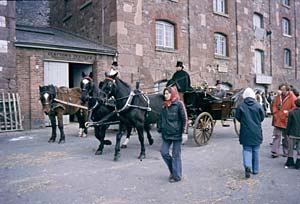
Exeter Stories
Exeter folk and friends in their own words - │ << Previous story │ Next story >> │
Why Exeter was chosen for filming the Onedin Line
One of the main reasons for Exeter being chosen as a location for shooting the 'Onedin Line' series is that it is an inland port of the early 1800's which is non-tidal.
There has been little modernisation of the area since the quayside and warehouses were built in 1835, and it therefore gives an excellent authentic background for the Victorian period.
Being non-tidal it has the advantage that filming can take place throughout the day without the vessels rising and falling against the quayside. something which could be troublesome where the shooting of one short scene (probably only lasting a few seconds on screen) can take all day. Professional actors can sometimes have difficulty in remembering their lines.
The Exeter Industrial Archaeology Group, of which I am secretary, was contacted by the BBC early in the year with a request for assistance to check the authenticity of the surroundings and also to obtain the necessary 'props' (horses, wagons, extras, etc.)
Connections through the insurance business helped in tracing owners of such unusual items as wagons with trained teams of shires which would back, rear, or gallop to order.
Piles of ironware, coal, and other goods were also necessary, and local scrap yards were experiencing an unusual demand for suitable lengths of pipe and railway track, although a large proportion of the paraphernalia lying around on the set was in fact fibreglass, which gave the extras anxious moments when they inadvertently picked up the wrong object to load on the ships.
Although the Exeter quay is meant to represent Liverpool in the programme, the set is authentic for the period. The buildings, consisting of the two massive stone warehouses built in the 1830's, the pub, and the open-sided fish market are typical. The ornate customs house, on the other hand. is really two centuries older and was the first brick built building in the city.
The "furniture" came from many sources, much of it brought by the BBC from their own 'props' store. The collection of carriages came from Reading where a collector specialises in the highly remunerative business of hiring historic transport to film companies. The Landau which features in most of the episodes once belonged to the Duke of Wellington, and the hansom cab spent its life in the streets of Edinburgh.
"INSTANT" SHIPS
The sailing ships of "the Onedin Line" in fact number only two, but they come equipped with several sets of name boards and interchangeable superstructure. The "Charlotte Rhodes" a topsail schooner of the early 1900's, is by now too famous to require any introduction. Although a comparatively young ship she is typical of the type of vessel used in the coastal trade, taking cargo in the least time for the largest profit. The newcomer to the line this year is the brig "Marques" which was built in Spain about the same time as the "Charlotte Rhodes" though she looks more dilapidated than the "Charlotte Rhodes" she is claimed to be more seaworthy. In the series she is seen as a sailing ship, but fitted with a superstructure and funnel to turn her into a steamship. Interior shots of her engine room, and the sounds of her whistle were made on the "Bertha", a steam driven dredger built in the 1840's by the famous Isambard Kingdom Brunel, and which is the oldest working steam boat in existence.
The other reason for filming in Exeter is the proximity to the Exeter Maritime Museum whose collection of craft is much in evidence. Scenes supposedly in the Canaries or Cape Verde Islands were filmed off Dawlish Warren with the aid of the museums collection of Portuguese vessels.
Other areas of Exeter, and nearby Topsham, frequently appear in the series and local residents have great fun "spotting" locations. In fact, it often becomes difficult to follow the story whilst engrossed in guessing the location of the shot and the identity of the extras!
The one thing that the BBC could not choose down here was the weather. The finished product is a tribute to the lighting crew and to the cast- iron constitutions of the actors and all others involved, as the weather was dreadful. Temperatures were only just above freezing and the skies were permanently overcast. A howling gale brought alternate showers of rain and snow, but the episodes featuring the Canary Islands positively radiate warmth - though the trained eye can spot the wet sleeves that weren't covered by umbrellas during rehearsal and previous 'takes'.
This article was written by Alan H Mazonowicz soon after the filming the Onedin Line in 1976 ended, and published inthe Commercial Union Staff Magazine. Used with permission. Photos by Alan H Mazonowicz.
 A horse wrangler walks next to the horses while filming.
A horse wrangler walks next to the horses while filming.  This shot was supposed to be in the Canary Islands - actors and crew were frozen with snow threatening.
This shot was supposed to be in the Canary Islands - actors and crew were frozen with snow threatening.
│ Top of Page │